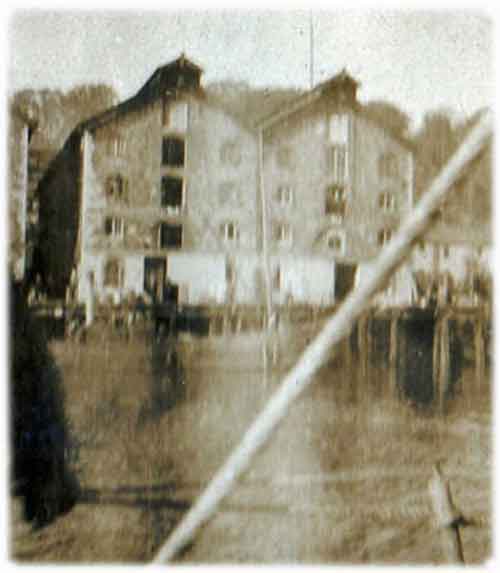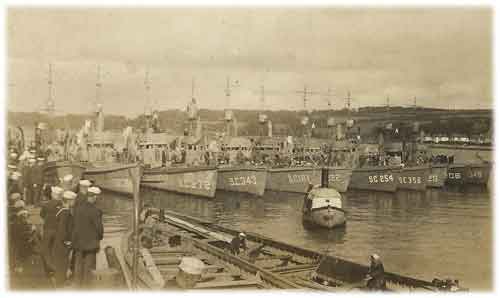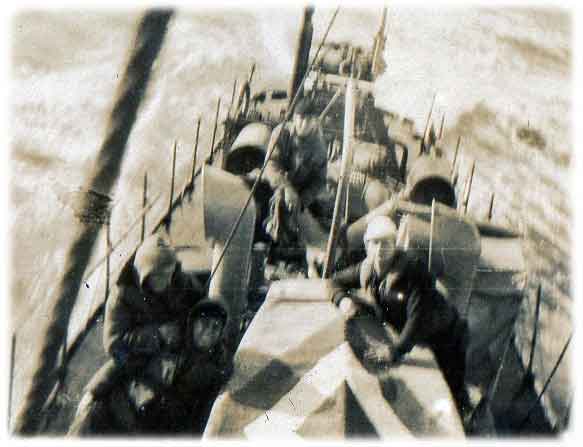
During World War One, the need for an effective anti-submarine vessel was hampered by the fact that technology for underwater detection was in its infancy. The existing device of the plate hydrophone had a big failing in that though it could detect the sound of a submarine,it could not give a direction for the source of the signal.
The US and Canadian- built, 80 foot Motor Launches were of a limited success, but it was the coming together of radio telephony, and directional hydrophones, as well as depth charge technology that brought about a new innovative craft. This was called the Subchaser.

Subchaser SC343 in Cork Harbour
The United States submarine chaser, or subchaser was the first serious attempt at a dedicated anti-submarine vessel. They were largely of wooden construction, 110 feet in length, and powered by three petrol engines, giving a cruising speed of 12 knots.
They were the first naval craft to have directional hydrophones, wireless telephones, and the new ‘y gun’ for firing patterns of depth charges outwards from the hull. They also had armament of a 3” deck gun, as well as depth charge racks astern.
Thirty subchasers,under the command of Captain A.J. Hepburn arrived in Queenstown, Cork, Ireland, on the 21st of August 1918. They were directed up the River Lee, past Haulbowline and Monkstown, and arrived at their moorings opposite Passage West
This was to be the Queenstown Base, with quarters, some stores, and offices provided in the Passage Granary. These brick-built granary buildings, beside Passage Dockyard, were built in the the late 1800s. They fronted the river and had a deep wharf. Previously they had been used to quarter British soldiers.

The granary, at Passage West, used as the US Subchaser Barracks
There were also stores depots on the quays of Cobh (Queenstown) as well as on Haulbowline Island. A training and lecture facility was organised in a rented premises in Ringaskiddy, close to the site of the present Port of Cork deepwater berth .
From the end of August until the 14th of September 1918, the boats and crews were involved in continuous training, some with United States submarines in Bantry Bay. Hunting patrols began on the 20th of October.

Picture showing view from Subchaser base towards Rushbrook
The tactics used were usually that of a three-boat unit. One subchaser was designated flagship, and this small group would patrol a pre-determined area, stopping engines and drifting about a mile apart, attempting to detect underwater noises of submarine engines or propellors.

SC254 in Irish Sea
In the event of a contact being made by all three boats, the flagship would plot a fix using the directions given by all boats. Then a pattern of depth charges would be dropped to try to damage or destroy the sub.
The 110 foot subchaser was a fine sea boat, but was never designed to withstand the wild Atlantic seas off Ireland. Constant leaks from decks and windows, choking petrol fumes in the officers quarters, and constant seasickness from the rolling motion, were the lot of crews of these craft.

Site of Subchaser base today
In heavy weather they would be almost awash, with only the pilot house showing above the waves. The depth charge racks were felt to be too heavy and made the vessels prone to taking seas over the stern. Many reports of German submarines from coastwatchers and others were actually subchasers ploughing through heavy seas. They were however, a great improvement on the 80-foot motor launches of the British and French forces. Nearly all the officers were drawn from the US Naval Reserve, and these little ships were their first commands

Subchaser in heavy seas
With the Armistice, in November 1918, there was no longer a need for anti-submarine forces. All the Queenstown subchasers departed Cork Harbour, in the company of submarine tender USS Bushnell and her remaining L-Class submarines on Tuesday, the 26th of November, 1918.
The newspapers of the day reported that they were given an enthusiastic send-off by crowds on shore.
They were bound for Plymouth, England. From there, some joined the North Sea mine clearance detachment. Others were set to Russia, with the remaining returning to the USA via the Azores.
The majority were then sold into private hands. Ironically, some ended up in the hands of alcohol smugglers during the era of Prohibition, going between the US and Canada with illicit cargoes.
SOURCES
There have been a number of publications detailing the history of Queenstown (Cobh) during World War One. The standard reference works are those those listed below
Danger Zone. The story of the Queenstown Command.
By E.Keeble Chatterton
Little, Brown and Co, Boston 1934
(copy available in Cork City Library – local history section top floor)
The Victory at Sea. By Rear-Admiral William Sowden Sims, Doubleday, Page and Company, New York, 1921.
Simsadus London, The American Navy in Europe.
By John Langdon Leighton.
Henry Holt & Co, New York, 1921.
Available to download here
Annual Report of the Secretary of the Navy
For the Fiscal Year, 1918
Available to download here
Officers and Enlisted Men of the US Navy who died during WW1
Available to download here
Bayley’s Navy,
by Vice Admiral Walter.S.Delany (Rtd)
Available to download here
American Participation in the Great War,
by Captain Dudley W.Knox.
Available to download here
Naval Aviation in WW1,
by Adrian O. Van Wyen.
Available to download here
For Operational Records Various files from the Public Records Office,of the United Kingdom, Kew are invaluable, especially records of ADM137, which were files bound for the official history of WW1 Naval Operations. None of these records are digitised yet, and can only be accessed by visiting the British Public Records Office, Kew, near London.
www.nationalarchives.gov.uk/
For photographs of the Queenstown Command, the following websites have many photographs available to download free of charge. Most of the aforementioned publications also have photographic illustrations.
US Naval History and Heritage Command website
www.history.navy.mil
United States National Archives Website
www.archives.gov/
The British Imperial War Museum
www.iwm.org.uk/research
This site contains many photographs of US and British Naval operations in Ireland. Importantly, it also has a number of copies of unique newsreel footage. These can be played on the site.
